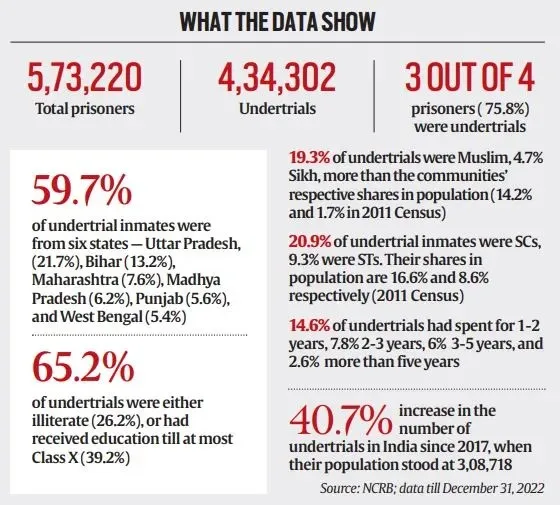Syllabus: GS2/Judiciary
Context
- Recently, the Union Home Minister said that undertrials who have spent more than a third of the maximum prescribed sentence for the crime they are accused of committing should be released before Constitution Day (November 26).
Undertrial Prisoners in India
- Undertrial prisoners are those who are in judicial custody while awaiting trial. Despite being presumed innocent until proven guilty, many of these individuals spend years in prison due to prolonged legal procedures and their inability to afford bail.
- Section 479 of the Bharatiya Nagarik Suraksha Sanhita (BNSS): It allows for the release of first-time offenders who have served one-third of their maximum sentence and other undertrials who have served half of their maximum sentence.
- This same standard was provided under the previously applicable Section 436A of the Code of Criminal Procedure, 1973 (CrPC).
Current State of Undertrial Prisoners
Overcrowding:

- According to the NCRB’s report Prison Statistics India 2022, Indian prisons had an occupancy rate of 131%, with 5,73,220 inmates against a capacity of 4,36,266.
- 4,34,302 are undertrials against whom cases are still pending, amounting to nearly 75.8% of all prisoners in India.
- As of December 31, 2022, around 8.6% of all undertrial prisoners had been in prison for more than three years.
- It leads to inhumane living conditions, inadequate medical care, and increased risk of violence and disease and hampers the rehabilitation and reformation processes.
Prolonged Detention:
- Many undertrial prisoners remain in jail for periods exceeding the maximum sentence for their alleged offences.
- It is often due to delays in the judicial process, lack of legal representation, and administrative inefficiencies.
Impact on Vulnerable Groups:
- Women, juveniles, and individuals from marginalised communities are disproportionately affected.
- Women undertrials, especially those with young children, face additional hardships due to inadequate facilities and support systems.
Reforms Related To India’s Undertrial Prisoner System
- Supreme Court Directives: Recently, the Supreme court directed jail authorities to identify and release eligible undertrials who have served a significant portion of their maximum sentence under Section 479 of the BNSS.
- Special Drives: The court has mandated special drives to identify eligible undertrials, including women and those with young children, to expedite their release.
- It aims to ensure that no eligible prisoner remains incarcerated due to administrative delays.
- Fast-Track Courts: To address the backlog of cases, the government has proposed the establishment of fast-track courts. These courts will focus on expediting trials for petty offences and cases pending for extended periods
- It is expected to reduce the number of undertrials and alleviate prison overcrowding.
- Legal Aid and Representation: Enhancing access to legal aid and representation is crucial. The National Legal Services Authority (NALSA) and other organisations are working to provide free legal services to undertrials, ensuring they receive timely and fair trials.
- Policy Reforms: The government is considering broader policy reforms to address the root causes of prolonged detention that includes revising bail laws, improving prison management, and ensuring better coordination between the judiciary and prison authorities.
- Bail Law Reforms: The Supreme Court has highlighted the need for comprehensive bail law reforms. In the case of Satender Kumar Antil vs CBI, the Court provided guidelines for timely disposal of bail applications and emphasised the principle of ‘bail not jail’.
- However, effective implementation requires a deeper understanding of the socio-economic barriers that prevent undertrials from securing bail.
- Judicial and Administrative Efficiency: Addressing the backlog of cases through judicial reforms is essential. Increasing the number of judges and improving court infrastructure can help expedite trials and reduce the duration of pretrial detention.
- Additionally, implementing guidelines to prevent arbitrary arrests can minimise unnecessary detentions.
Conclusion
- The state of undertrial prisoners in India highlights significant flaws in the criminal justice system. However, recent initiatives and directives from the Supreme Court offer hope for meaningful change.
- By implementing these measures, India can ensure that justice is not delayed and that the rights of undertrial prisoners are upheld.
Previous article
Role of Urbanization in Boosting Skills and Employment
Next article
Disparities in the Quality of Packaged Food